Leadership Development and Transformational Leadership Essay
VerifiedAdded on 2021/05/31
|12
|3623
|50
Essay
AI Summary
This essay delves into the multifaceted realm of leadership, particularly within the context of Human Resource Management (HRM). It begins by defining leadership and its evolution, emphasizing its dynamic and flexible nature. The essay explores various leadership theories, with a focus on transformational leadership, illustrating its principles and practical application through examples like Jeff Bezos's leadership at Amazon. It discusses the importance of creating an inspiring vision, motivating employees, managing change, and building trust. The essay also includes a self-reflective component, analyzing questionnaires and team activities designed to assess leadership styles and identify areas for personal development. The author identifies areas for improvement, including delegation, the use of motivational techniques, time management, and strategic planning, highlighting the importance of these skills in effective leadership. The essay concludes by emphasizing the significance of continuous self-improvement and adapting leadership approaches to different situations.
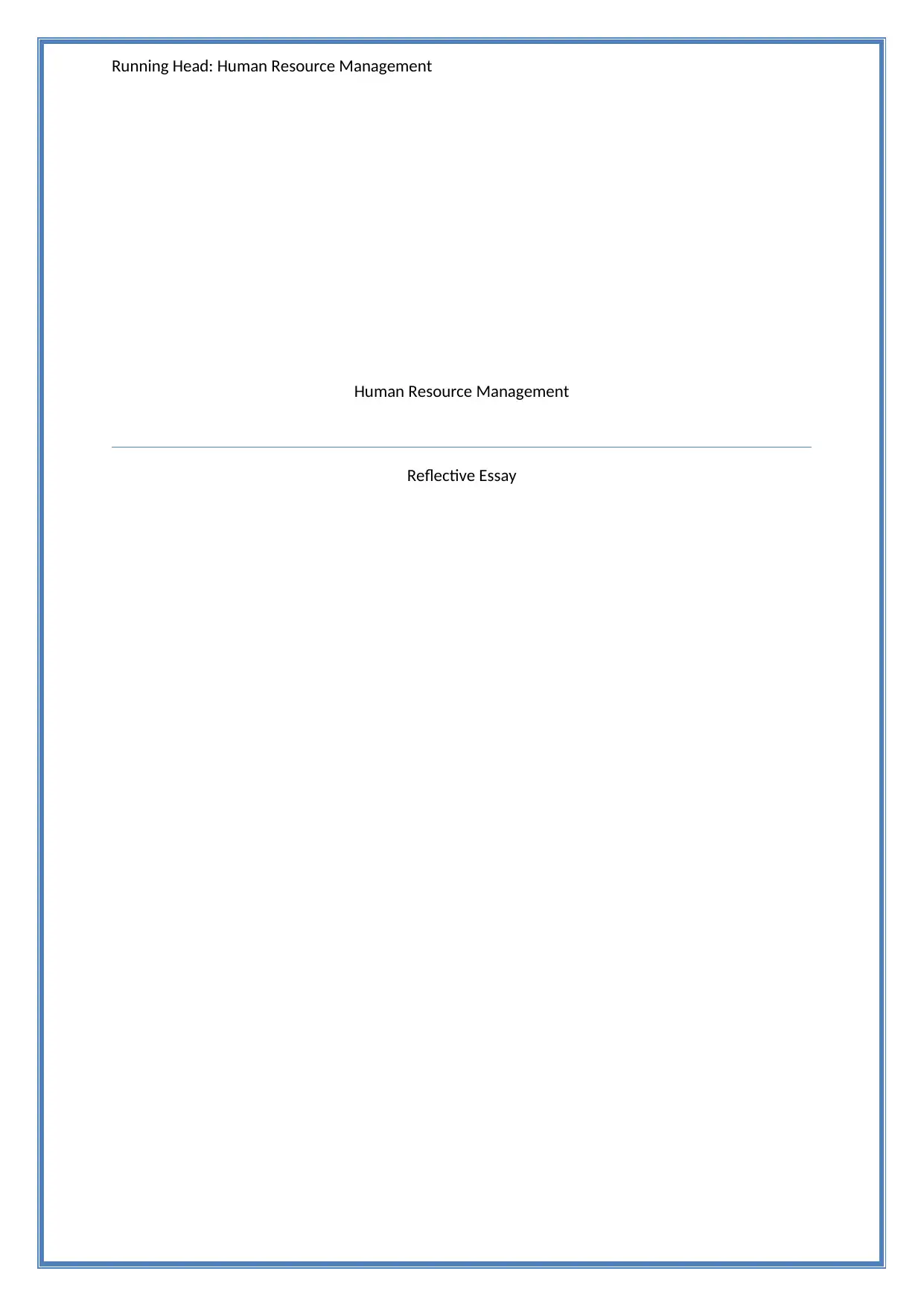
Running Head: Human Resource Management
Human Resource Management
Reflective Essay
Human Resource Management
Reflective Essay
Paraphrase This Document
Need a fresh take? Get an instant paraphrase of this document with our AI Paraphraser
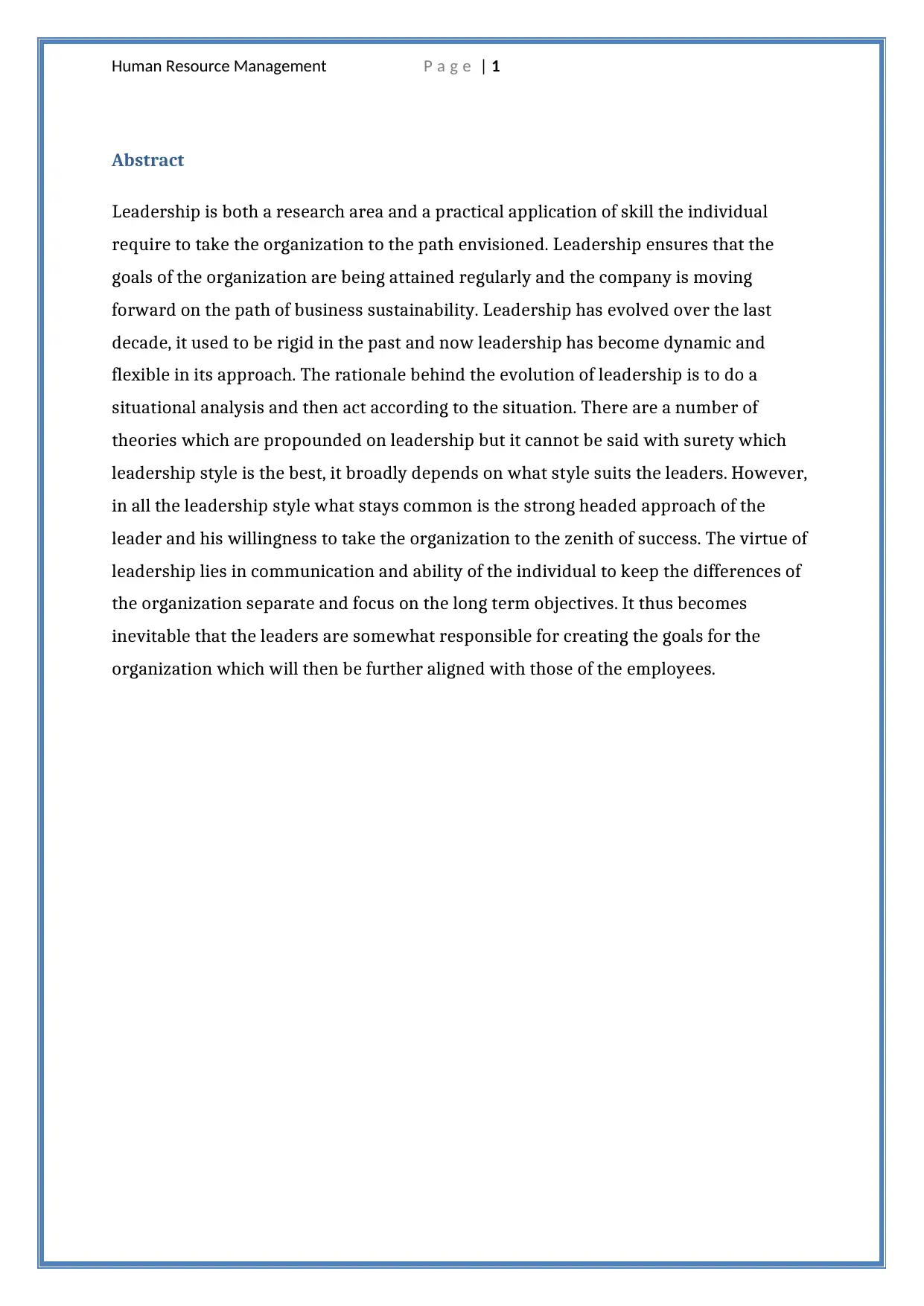
Human Resource Management P a g e | 1
Abstract
Leadership is both a research area and a practical application of skill the individual
require to take the organization to the path envisioned. Leadership ensures that the
goals of the organization are being attained regularly and the company is moving
forward on the path of business sustainability. Leadership has evolved over the last
decade, it used to be rigid in the past and now leadership has become dynamic and
flexible in its approach. The rationale behind the evolution of leadership is to do a
situational analysis and then act according to the situation. There are a number of
theories which are propounded on leadership but it cannot be said with surety which
leadership style is the best, it broadly depends on what style suits the leaders. However,
in all the leadership style what stays common is the strong headed approach of the
leader and his willingness to take the organization to the zenith of success. The virtue of
leadership lies in communication and ability of the individual to keep the differences of
the organization separate and focus on the long term objectives. It thus becomes
inevitable that the leaders are somewhat responsible for creating the goals for the
organization which will then be further aligned with those of the employees.
Abstract
Leadership is both a research area and a practical application of skill the individual
require to take the organization to the path envisioned. Leadership ensures that the
goals of the organization are being attained regularly and the company is moving
forward on the path of business sustainability. Leadership has evolved over the last
decade, it used to be rigid in the past and now leadership has become dynamic and
flexible in its approach. The rationale behind the evolution of leadership is to do a
situational analysis and then act according to the situation. There are a number of
theories which are propounded on leadership but it cannot be said with surety which
leadership style is the best, it broadly depends on what style suits the leaders. However,
in all the leadership style what stays common is the strong headed approach of the
leader and his willingness to take the organization to the zenith of success. The virtue of
leadership lies in communication and ability of the individual to keep the differences of
the organization separate and focus on the long term objectives. It thus becomes
inevitable that the leaders are somewhat responsible for creating the goals for the
organization which will then be further aligned with those of the employees.
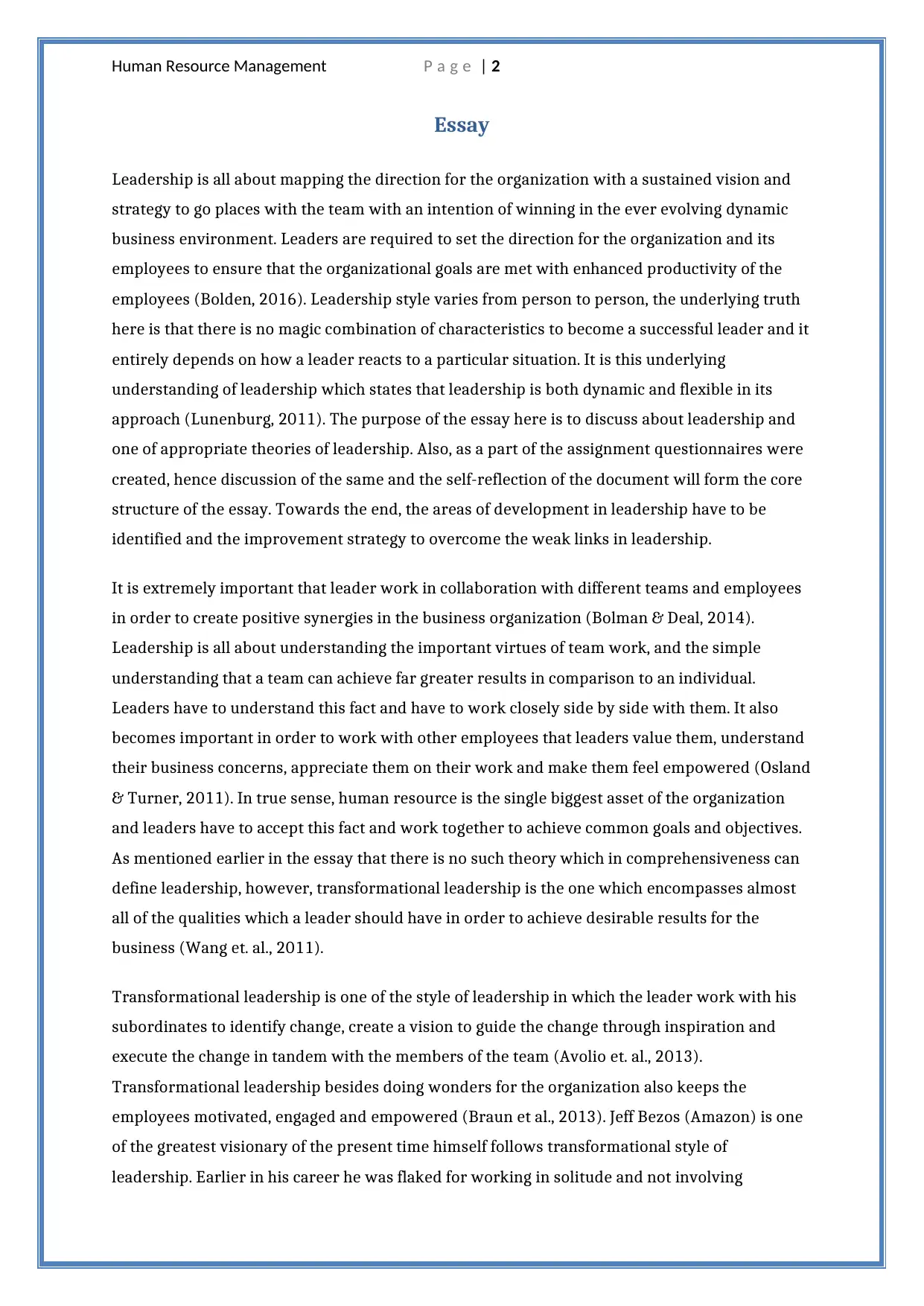
Human Resource Management P a g e | 2
Essay
Leadership is all about mapping the direction for the organization with a sustained vision and
strategy to go places with the team with an intention of winning in the ever evolving dynamic
business environment. Leaders are required to set the direction for the organization and its
employees to ensure that the organizational goals are met with enhanced productivity of the
employees (Bolden, 2016). Leadership style varies from person to person, the underlying truth
here is that there is no magic combination of characteristics to become a successful leader and it
entirely depends on how a leader reacts to a particular situation. It is this underlying
understanding of leadership which states that leadership is both dynamic and flexible in its
approach (Lunenburg, 2011). The purpose of the essay here is to discuss about leadership and
one of appropriate theories of leadership. Also, as a part of the assignment questionnaires were
created, hence discussion of the same and the self-reflection of the document will form the core
structure of the essay. Towards the end, the areas of development in leadership have to be
identified and the improvement strategy to overcome the weak links in leadership.
It is extremely important that leader work in collaboration with different teams and employees
in order to create positive synergies in the business organization (Bolman & Deal, 2014).
Leadership is all about understanding the important virtues of team work, and the simple
understanding that a team can achieve far greater results in comparison to an individual.
Leaders have to understand this fact and have to work closely side by side with them. It also
becomes important in order to work with other employees that leaders value them, understand
their business concerns, appreciate them on their work and make them feel empowered (Osland
& Turner, 2011). In true sense, human resource is the single biggest asset of the organization
and leaders have to accept this fact and work together to achieve common goals and objectives.
As mentioned earlier in the essay that there is no such theory which in comprehensiveness can
define leadership, however, transformational leadership is the one which encompasses almost
all of the qualities which a leader should have in order to achieve desirable results for the
business (Wang et. al., 2011).
Transformational leadership is one of the style of leadership in which the leader work with his
subordinates to identify change, create a vision to guide the change through inspiration and
execute the change in tandem with the members of the team (Avolio et. al., 2013).
Transformational leadership besides doing wonders for the organization also keeps the
employees motivated, engaged and empowered (Braun et al., 2013). Jeff Bezos (Amazon) is one
of the greatest visionary of the present time himself follows transformational style of
leadership. Earlier in his career he was flaked for working in solitude and not involving
Essay
Leadership is all about mapping the direction for the organization with a sustained vision and
strategy to go places with the team with an intention of winning in the ever evolving dynamic
business environment. Leaders are required to set the direction for the organization and its
employees to ensure that the organizational goals are met with enhanced productivity of the
employees (Bolden, 2016). Leadership style varies from person to person, the underlying truth
here is that there is no magic combination of characteristics to become a successful leader and it
entirely depends on how a leader reacts to a particular situation. It is this underlying
understanding of leadership which states that leadership is both dynamic and flexible in its
approach (Lunenburg, 2011). The purpose of the essay here is to discuss about leadership and
one of appropriate theories of leadership. Also, as a part of the assignment questionnaires were
created, hence discussion of the same and the self-reflection of the document will form the core
structure of the essay. Towards the end, the areas of development in leadership have to be
identified and the improvement strategy to overcome the weak links in leadership.
It is extremely important that leader work in collaboration with different teams and employees
in order to create positive synergies in the business organization (Bolman & Deal, 2014).
Leadership is all about understanding the important virtues of team work, and the simple
understanding that a team can achieve far greater results in comparison to an individual.
Leaders have to understand this fact and have to work closely side by side with them. It also
becomes important in order to work with other employees that leaders value them, understand
their business concerns, appreciate them on their work and make them feel empowered (Osland
& Turner, 2011). In true sense, human resource is the single biggest asset of the organization
and leaders have to accept this fact and work together to achieve common goals and objectives.
As mentioned earlier in the essay that there is no such theory which in comprehensiveness can
define leadership, however, transformational leadership is the one which encompasses almost
all of the qualities which a leader should have in order to achieve desirable results for the
business (Wang et. al., 2011).
Transformational leadership is one of the style of leadership in which the leader work with his
subordinates to identify change, create a vision to guide the change through inspiration and
execute the change in tandem with the members of the team (Avolio et. al., 2013).
Transformational leadership besides doing wonders for the organization also keeps the
employees motivated, engaged and empowered (Braun et al., 2013). Jeff Bezos (Amazon) is one
of the greatest visionary of the present time himself follows transformational style of
leadership. Earlier in his career he was flaked for working in solitude and not involving
⊘ This is a preview!⊘
Do you want full access?
Subscribe today to unlock all pages.

Trusted by 1+ million students worldwide
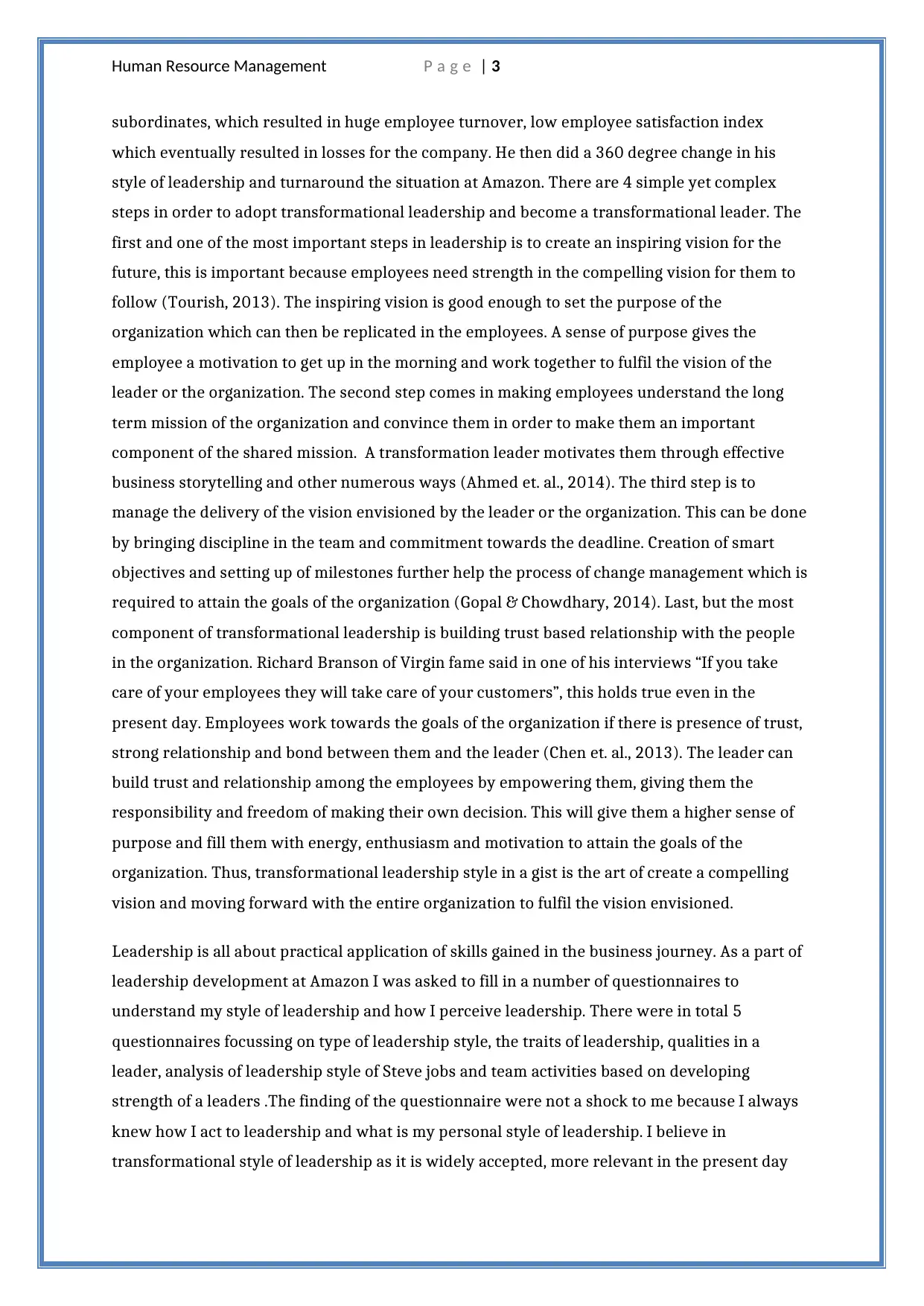
Human Resource Management P a g e | 3
subordinates, which resulted in huge employee turnover, low employee satisfaction index
which eventually resulted in losses for the company. He then did a 360 degree change in his
style of leadership and turnaround the situation at Amazon. There are 4 simple yet complex
steps in order to adopt transformational leadership and become a transformational leader. The
first and one of the most important steps in leadership is to create an inspiring vision for the
future, this is important because employees need strength in the compelling vision for them to
follow (Tourish, 2013). The inspiring vision is good enough to set the purpose of the
organization which can then be replicated in the employees. A sense of purpose gives the
employee a motivation to get up in the morning and work together to fulfil the vision of the
leader or the organization. The second step comes in making employees understand the long
term mission of the organization and convince them in order to make them an important
component of the shared mission. A transformation leader motivates them through effective
business storytelling and other numerous ways (Ahmed et. al., 2014). The third step is to
manage the delivery of the vision envisioned by the leader or the organization. This can be done
by bringing discipline in the team and commitment towards the deadline. Creation of smart
objectives and setting up of milestones further help the process of change management which is
required to attain the goals of the organization (Gopal & Chowdhary, 2014). Last, but the most
component of transformational leadership is building trust based relationship with the people
in the organization. Richard Branson of Virgin fame said in one of his interviews “If you take
care of your employees they will take care of your customers”, this holds true even in the
present day. Employees work towards the goals of the organization if there is presence of trust,
strong relationship and bond between them and the leader (Chen et. al., 2013). The leader can
build trust and relationship among the employees by empowering them, giving them the
responsibility and freedom of making their own decision. This will give them a higher sense of
purpose and fill them with energy, enthusiasm and motivation to attain the goals of the
organization. Thus, transformational leadership style in a gist is the art of create a compelling
vision and moving forward with the entire organization to fulfil the vision envisioned.
Leadership is all about practical application of skills gained in the business journey. As a part of
leadership development at Amazon I was asked to fill in a number of questionnaires to
understand my style of leadership and how I perceive leadership. There were in total 5
questionnaires focussing on type of leadership style, the traits of leadership, qualities in a
leader, analysis of leadership style of Steve jobs and team activities based on developing
strength of a leaders .The finding of the questionnaire were not a shock to me because I always
knew how I act to leadership and what is my personal style of leadership. I believe in
transformational style of leadership as it is widely accepted, more relevant in the present day
subordinates, which resulted in huge employee turnover, low employee satisfaction index
which eventually resulted in losses for the company. He then did a 360 degree change in his
style of leadership and turnaround the situation at Amazon. There are 4 simple yet complex
steps in order to adopt transformational leadership and become a transformational leader. The
first and one of the most important steps in leadership is to create an inspiring vision for the
future, this is important because employees need strength in the compelling vision for them to
follow (Tourish, 2013). The inspiring vision is good enough to set the purpose of the
organization which can then be replicated in the employees. A sense of purpose gives the
employee a motivation to get up in the morning and work together to fulfil the vision of the
leader or the organization. The second step comes in making employees understand the long
term mission of the organization and convince them in order to make them an important
component of the shared mission. A transformation leader motivates them through effective
business storytelling and other numerous ways (Ahmed et. al., 2014). The third step is to
manage the delivery of the vision envisioned by the leader or the organization. This can be done
by bringing discipline in the team and commitment towards the deadline. Creation of smart
objectives and setting up of milestones further help the process of change management which is
required to attain the goals of the organization (Gopal & Chowdhary, 2014). Last, but the most
component of transformational leadership is building trust based relationship with the people
in the organization. Richard Branson of Virgin fame said in one of his interviews “If you take
care of your employees they will take care of your customers”, this holds true even in the
present day. Employees work towards the goals of the organization if there is presence of trust,
strong relationship and bond between them and the leader (Chen et. al., 2013). The leader can
build trust and relationship among the employees by empowering them, giving them the
responsibility and freedom of making their own decision. This will give them a higher sense of
purpose and fill them with energy, enthusiasm and motivation to attain the goals of the
organization. Thus, transformational leadership style in a gist is the art of create a compelling
vision and moving forward with the entire organization to fulfil the vision envisioned.
Leadership is all about practical application of skills gained in the business journey. As a part of
leadership development at Amazon I was asked to fill in a number of questionnaires to
understand my style of leadership and how I perceive leadership. There were in total 5
questionnaires focussing on type of leadership style, the traits of leadership, qualities in a
leader, analysis of leadership style of Steve jobs and team activities based on developing
strength of a leaders .The finding of the questionnaire were not a shock to me because I always
knew how I act to leadership and what is my personal style of leadership. I believe in
transformational style of leadership as it is widely accepted, more relevant in the present day
Paraphrase This Document
Need a fresh take? Get an instant paraphrase of this document with our AI Paraphraser
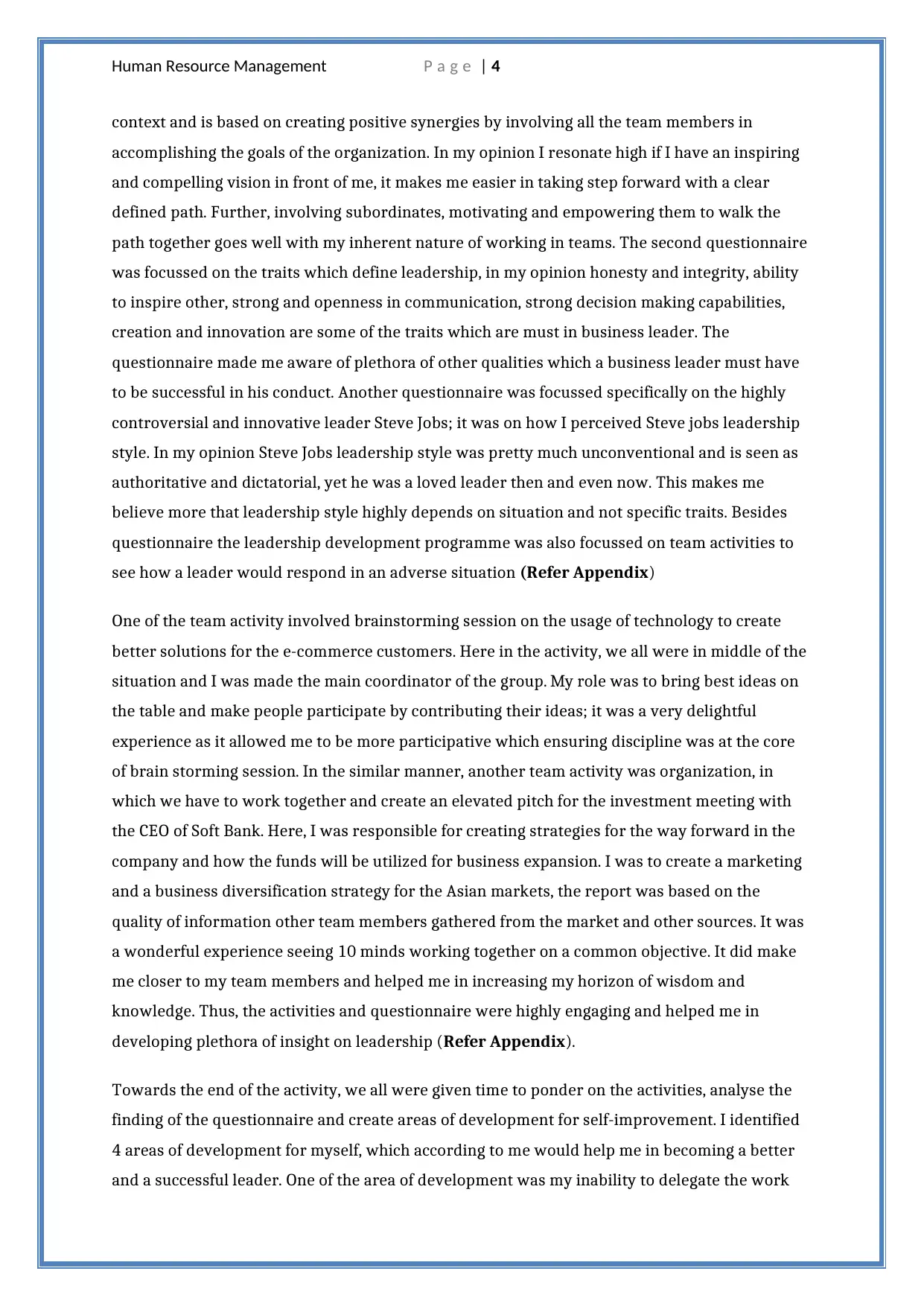
Human Resource Management P a g e | 4
context and is based on creating positive synergies by involving all the team members in
accomplishing the goals of the organization. In my opinion I resonate high if I have an inspiring
and compelling vision in front of me, it makes me easier in taking step forward with a clear
defined path. Further, involving subordinates, motivating and empowering them to walk the
path together goes well with my inherent nature of working in teams. The second questionnaire
was focussed on the traits which define leadership, in my opinion honesty and integrity, ability
to inspire other, strong and openness in communication, strong decision making capabilities,
creation and innovation are some of the traits which are must in business leader. The
questionnaire made me aware of plethora of other qualities which a business leader must have
to be successful in his conduct. Another questionnaire was focussed specifically on the highly
controversial and innovative leader Steve Jobs; it was on how I perceived Steve jobs leadership
style. In my opinion Steve Jobs leadership style was pretty much unconventional and is seen as
authoritative and dictatorial, yet he was a loved leader then and even now. This makes me
believe more that leadership style highly depends on situation and not specific traits. Besides
questionnaire the leadership development programme was also focussed on team activities to
see how a leader would respond in an adverse situation (Refer Appendix)
One of the team activity involved brainstorming session on the usage of technology to create
better solutions for the e-commerce customers. Here in the activity, we all were in middle of the
situation and I was made the main coordinator of the group. My role was to bring best ideas on
the table and make people participate by contributing their ideas; it was a very delightful
experience as it allowed me to be more participative which ensuring discipline was at the core
of brain storming session. In the similar manner, another team activity was organization, in
which we have to work together and create an elevated pitch for the investment meeting with
the CEO of Soft Bank. Here, I was responsible for creating strategies for the way forward in the
company and how the funds will be utilized for business expansion. I was to create a marketing
and a business diversification strategy for the Asian markets, the report was based on the
quality of information other team members gathered from the market and other sources. It was
a wonderful experience seeing 10 minds working together on a common objective. It did make
me closer to my team members and helped me in increasing my horizon of wisdom and
knowledge. Thus, the activities and questionnaire were highly engaging and helped me in
developing plethora of insight on leadership (Refer Appendix).
Towards the end of the activity, we all were given time to ponder on the activities, analyse the
finding of the questionnaire and create areas of development for self-improvement. I identified
4 areas of development for myself, which according to me would help me in becoming a better
and a successful leader. One of the area of development was my inability to delegate the work
context and is based on creating positive synergies by involving all the team members in
accomplishing the goals of the organization. In my opinion I resonate high if I have an inspiring
and compelling vision in front of me, it makes me easier in taking step forward with a clear
defined path. Further, involving subordinates, motivating and empowering them to walk the
path together goes well with my inherent nature of working in teams. The second questionnaire
was focussed on the traits which define leadership, in my opinion honesty and integrity, ability
to inspire other, strong and openness in communication, strong decision making capabilities,
creation and innovation are some of the traits which are must in business leader. The
questionnaire made me aware of plethora of other qualities which a business leader must have
to be successful in his conduct. Another questionnaire was focussed specifically on the highly
controversial and innovative leader Steve Jobs; it was on how I perceived Steve jobs leadership
style. In my opinion Steve Jobs leadership style was pretty much unconventional and is seen as
authoritative and dictatorial, yet he was a loved leader then and even now. This makes me
believe more that leadership style highly depends on situation and not specific traits. Besides
questionnaire the leadership development programme was also focussed on team activities to
see how a leader would respond in an adverse situation (Refer Appendix)
One of the team activity involved brainstorming session on the usage of technology to create
better solutions for the e-commerce customers. Here in the activity, we all were in middle of the
situation and I was made the main coordinator of the group. My role was to bring best ideas on
the table and make people participate by contributing their ideas; it was a very delightful
experience as it allowed me to be more participative which ensuring discipline was at the core
of brain storming session. In the similar manner, another team activity was organization, in
which we have to work together and create an elevated pitch for the investment meeting with
the CEO of Soft Bank. Here, I was responsible for creating strategies for the way forward in the
company and how the funds will be utilized for business expansion. I was to create a marketing
and a business diversification strategy for the Asian markets, the report was based on the
quality of information other team members gathered from the market and other sources. It was
a wonderful experience seeing 10 minds working together on a common objective. It did make
me closer to my team members and helped me in increasing my horizon of wisdom and
knowledge. Thus, the activities and questionnaire were highly engaging and helped me in
developing plethora of insight on leadership (Refer Appendix).
Towards the end of the activity, we all were given time to ponder on the activities, analyse the
finding of the questionnaire and create areas of development for self-improvement. I identified
4 areas of development for myself, which according to me would help me in becoming a better
and a successful leader. One of the area of development was my inability to delegate the work
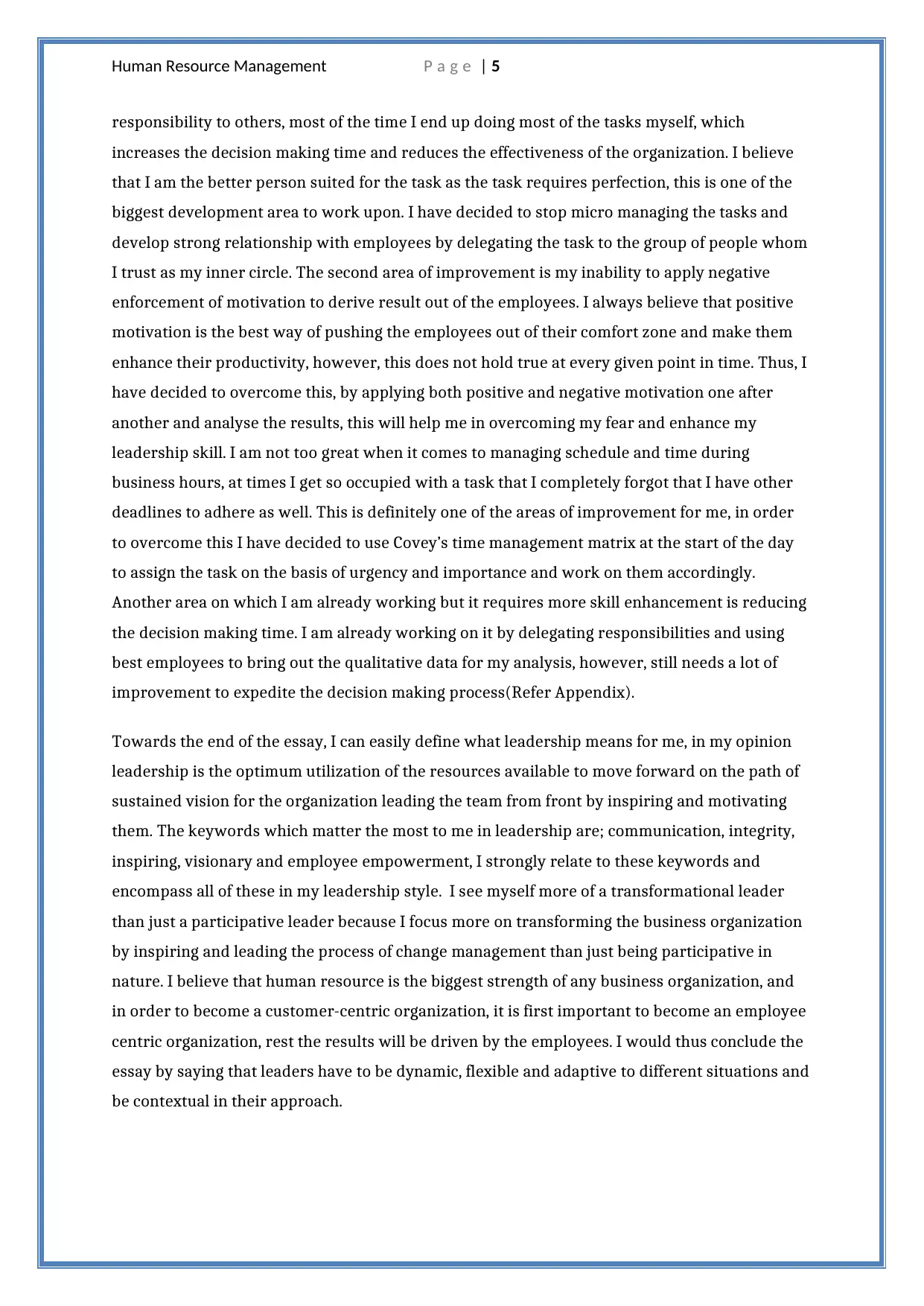
Human Resource Management P a g e | 5
responsibility to others, most of the time I end up doing most of the tasks myself, which
increases the decision making time and reduces the effectiveness of the organization. I believe
that I am the better person suited for the task as the task requires perfection, this is one of the
biggest development area to work upon. I have decided to stop micro managing the tasks and
develop strong relationship with employees by delegating the task to the group of people whom
I trust as my inner circle. The second area of improvement is my inability to apply negative
enforcement of motivation to derive result out of the employees. I always believe that positive
motivation is the best way of pushing the employees out of their comfort zone and make them
enhance their productivity, however, this does not hold true at every given point in time. Thus, I
have decided to overcome this, by applying both positive and negative motivation one after
another and analyse the results, this will help me in overcoming my fear and enhance my
leadership skill. I am not too great when it comes to managing schedule and time during
business hours, at times I get so occupied with a task that I completely forgot that I have other
deadlines to adhere as well. This is definitely one of the areas of improvement for me, in order
to overcome this I have decided to use Covey’s time management matrix at the start of the day
to assign the task on the basis of urgency and importance and work on them accordingly.
Another area on which I am already working but it requires more skill enhancement is reducing
the decision making time. I am already working on it by delegating responsibilities and using
best employees to bring out the qualitative data for my analysis, however, still needs a lot of
improvement to expedite the decision making process(Refer Appendix).
Towards the end of the essay, I can easily define what leadership means for me, in my opinion
leadership is the optimum utilization of the resources available to move forward on the path of
sustained vision for the organization leading the team from front by inspiring and motivating
them. The keywords which matter the most to me in leadership are; communication, integrity,
inspiring, visionary and employee empowerment, I strongly relate to these keywords and
encompass all of these in my leadership style. I see myself more of a transformational leader
than just a participative leader because I focus more on transforming the business organization
by inspiring and leading the process of change management than just being participative in
nature. I believe that human resource is the biggest strength of any business organization, and
in order to become a customer-centric organization, it is first important to become an employee
centric organization, rest the results will be driven by the employees. I would thus conclude the
essay by saying that leaders have to be dynamic, flexible and adaptive to different situations and
be contextual in their approach.
responsibility to others, most of the time I end up doing most of the tasks myself, which
increases the decision making time and reduces the effectiveness of the organization. I believe
that I am the better person suited for the task as the task requires perfection, this is one of the
biggest development area to work upon. I have decided to stop micro managing the tasks and
develop strong relationship with employees by delegating the task to the group of people whom
I trust as my inner circle. The second area of improvement is my inability to apply negative
enforcement of motivation to derive result out of the employees. I always believe that positive
motivation is the best way of pushing the employees out of their comfort zone and make them
enhance their productivity, however, this does not hold true at every given point in time. Thus, I
have decided to overcome this, by applying both positive and negative motivation one after
another and analyse the results, this will help me in overcoming my fear and enhance my
leadership skill. I am not too great when it comes to managing schedule and time during
business hours, at times I get so occupied with a task that I completely forgot that I have other
deadlines to adhere as well. This is definitely one of the areas of improvement for me, in order
to overcome this I have decided to use Covey’s time management matrix at the start of the day
to assign the task on the basis of urgency and importance and work on them accordingly.
Another area on which I am already working but it requires more skill enhancement is reducing
the decision making time. I am already working on it by delegating responsibilities and using
best employees to bring out the qualitative data for my analysis, however, still needs a lot of
improvement to expedite the decision making process(Refer Appendix).
Towards the end of the essay, I can easily define what leadership means for me, in my opinion
leadership is the optimum utilization of the resources available to move forward on the path of
sustained vision for the organization leading the team from front by inspiring and motivating
them. The keywords which matter the most to me in leadership are; communication, integrity,
inspiring, visionary and employee empowerment, I strongly relate to these keywords and
encompass all of these in my leadership style. I see myself more of a transformational leader
than just a participative leader because I focus more on transforming the business organization
by inspiring and leading the process of change management than just being participative in
nature. I believe that human resource is the biggest strength of any business organization, and
in order to become a customer-centric organization, it is first important to become an employee
centric organization, rest the results will be driven by the employees. I would thus conclude the
essay by saying that leaders have to be dynamic, flexible and adaptive to different situations and
be contextual in their approach.
⊘ This is a preview!⊘
Do you want full access?
Subscribe today to unlock all pages.

Trusted by 1+ million students worldwide
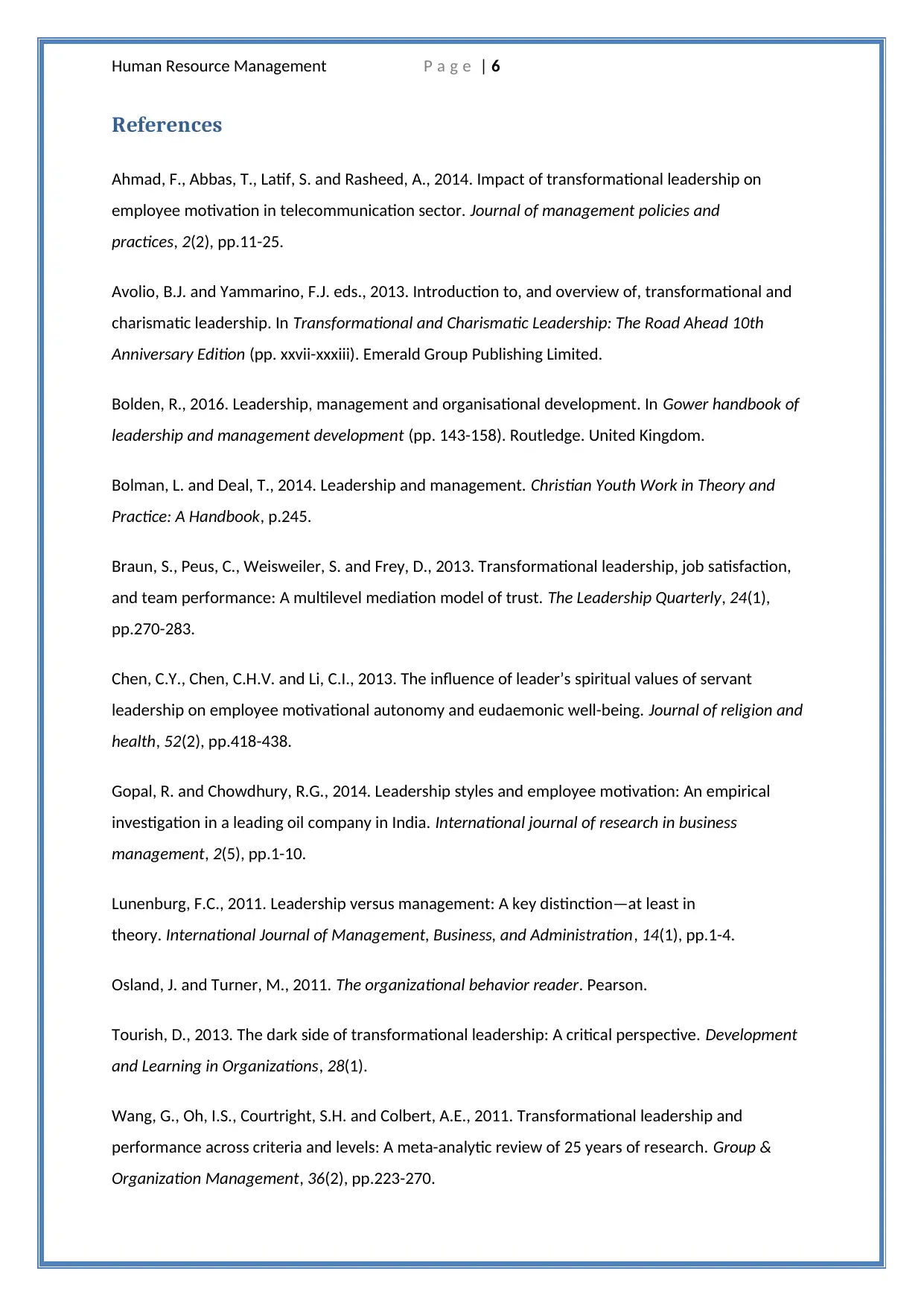
Human Resource Management P a g e | 6
References
Ahmad, F., Abbas, T., Latif, S. and Rasheed, A., 2014. Impact of transformational leadership on
employee motivation in telecommunication sector. Journal of management policies and
practices, 2(2), pp.11-25.
Avolio, B.J. and Yammarino, F.J. eds., 2013. Introduction to, and overview of, transformational and
charismatic leadership. In Transformational and Charismatic Leadership: The Road Ahead 10th
Anniversary Edition (pp. xxvii-xxxiii). Emerald Group Publishing Limited.
Bolden, R., 2016. Leadership, management and organisational development. In Gower handbook of
leadership and management development (pp. 143-158). Routledge. United Kingdom.
Bolman, L. and Deal, T., 2014. Leadership and management. Christian Youth Work in Theory and
Practice: A Handbook, p.245.
Braun, S., Peus, C., Weisweiler, S. and Frey, D., 2013. Transformational leadership, job satisfaction,
and team performance: A multilevel mediation model of trust. The Leadership Quarterly, 24(1),
pp.270-283.
Chen, C.Y., Chen, C.H.V. and Li, C.I., 2013. The influence of leader’s spiritual values of servant
leadership on employee motivational autonomy and eudaemonic well-being. Journal of religion and
health, 52(2), pp.418-438.
Gopal, R. and Chowdhury, R.G., 2014. Leadership styles and employee motivation: An empirical
investigation in a leading oil company in India. International journal of research in business
management, 2(5), pp.1-10.
Lunenburg, F.C., 2011. Leadership versus management: A key distinction—at least in
theory. International Journal of Management, Business, and Administration, 14(1), pp.1-4.
Osland, J. and Turner, M., 2011. The organizational behavior reader. Pearson.
Tourish, D., 2013. The dark side of transformational leadership: A critical perspective. Development
and Learning in Organizations, 28(1).
Wang, G., Oh, I.S., Courtright, S.H. and Colbert, A.E., 2011. Transformational leadership and
performance across criteria and levels: A meta-analytic review of 25 years of research. Group &
Organization Management, 36(2), pp.223-270.
References
Ahmad, F., Abbas, T., Latif, S. and Rasheed, A., 2014. Impact of transformational leadership on
employee motivation in telecommunication sector. Journal of management policies and
practices, 2(2), pp.11-25.
Avolio, B.J. and Yammarino, F.J. eds., 2013. Introduction to, and overview of, transformational and
charismatic leadership. In Transformational and Charismatic Leadership: The Road Ahead 10th
Anniversary Edition (pp. xxvii-xxxiii). Emerald Group Publishing Limited.
Bolden, R., 2016. Leadership, management and organisational development. In Gower handbook of
leadership and management development (pp. 143-158). Routledge. United Kingdom.
Bolman, L. and Deal, T., 2014. Leadership and management. Christian Youth Work in Theory and
Practice: A Handbook, p.245.
Braun, S., Peus, C., Weisweiler, S. and Frey, D., 2013. Transformational leadership, job satisfaction,
and team performance: A multilevel mediation model of trust. The Leadership Quarterly, 24(1),
pp.270-283.
Chen, C.Y., Chen, C.H.V. and Li, C.I., 2013. The influence of leader’s spiritual values of servant
leadership on employee motivational autonomy and eudaemonic well-being. Journal of religion and
health, 52(2), pp.418-438.
Gopal, R. and Chowdhury, R.G., 2014. Leadership styles and employee motivation: An empirical
investigation in a leading oil company in India. International journal of research in business
management, 2(5), pp.1-10.
Lunenburg, F.C., 2011. Leadership versus management: A key distinction—at least in
theory. International Journal of Management, Business, and Administration, 14(1), pp.1-4.
Osland, J. and Turner, M., 2011. The organizational behavior reader. Pearson.
Tourish, D., 2013. The dark side of transformational leadership: A critical perspective. Development
and Learning in Organizations, 28(1).
Wang, G., Oh, I.S., Courtright, S.H. and Colbert, A.E., 2011. Transformational leadership and
performance across criteria and levels: A meta-analytic review of 25 years of research. Group &
Organization Management, 36(2), pp.223-270.
Paraphrase This Document
Need a fresh take? Get an instant paraphrase of this document with our AI Paraphraser
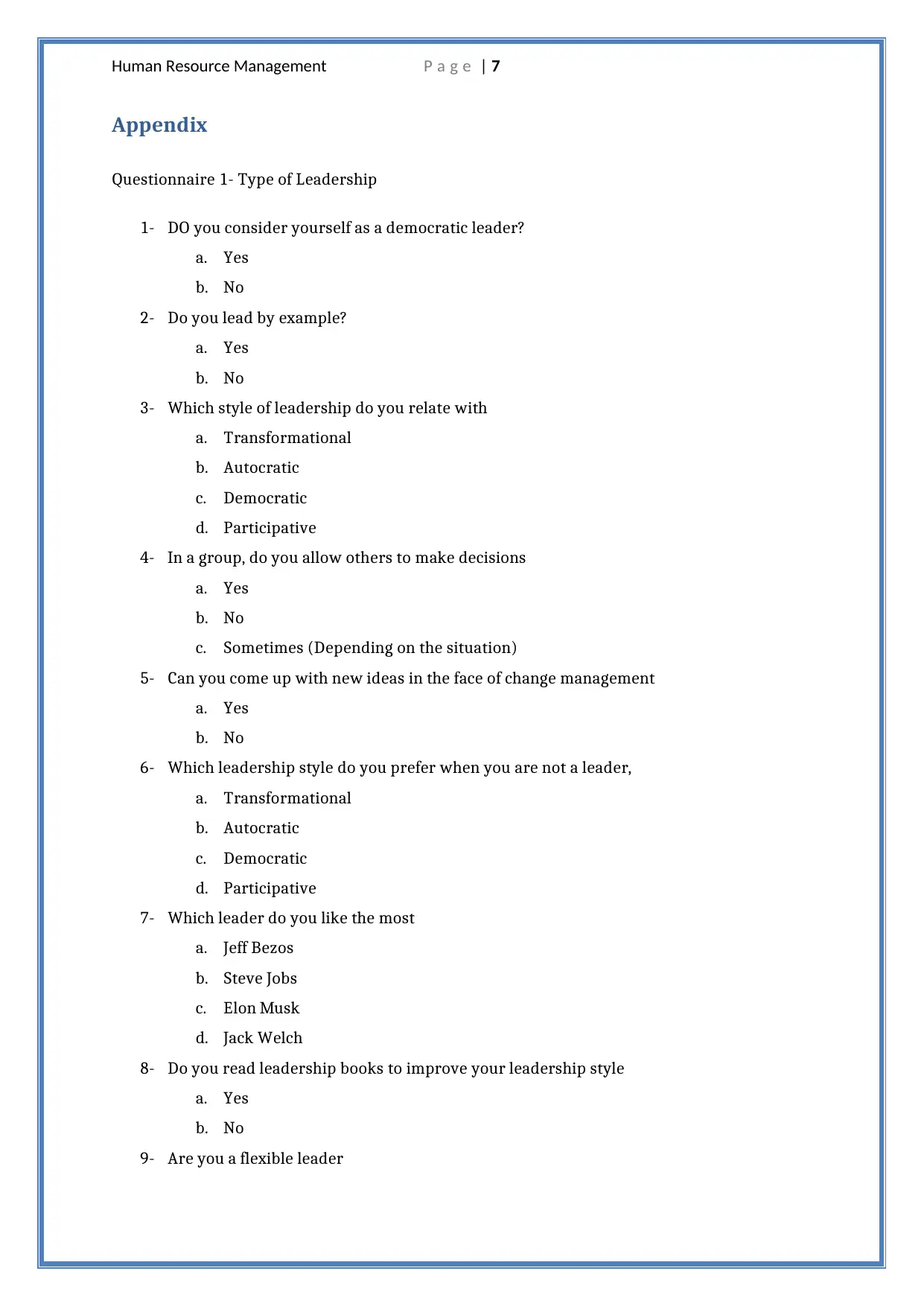
Human Resource Management P a g e | 7
Appendix
Questionnaire 1- Type of Leadership
1- DO you consider yourself as a democratic leader?
a. Yes
b. No
2- Do you lead by example?
a. Yes
b. No
3- Which style of leadership do you relate with
a. Transformational
b. Autocratic
c. Democratic
d. Participative
4- In a group, do you allow others to make decisions
a. Yes
b. No
c. Sometimes (Depending on the situation)
5- Can you come up with new ideas in the face of change management
a. Yes
b. No
6- Which leadership style do you prefer when you are not a leader,
a. Transformational
b. Autocratic
c. Democratic
d. Participative
7- Which leader do you like the most
a. Jeff Bezos
b. Steve Jobs
c. Elon Musk
d. Jack Welch
8- Do you read leadership books to improve your leadership style
a. Yes
b. No
9- Are you a flexible leader
Appendix
Questionnaire 1- Type of Leadership
1- DO you consider yourself as a democratic leader?
a. Yes
b. No
2- Do you lead by example?
a. Yes
b. No
3- Which style of leadership do you relate with
a. Transformational
b. Autocratic
c. Democratic
d. Participative
4- In a group, do you allow others to make decisions
a. Yes
b. No
c. Sometimes (Depending on the situation)
5- Can you come up with new ideas in the face of change management
a. Yes
b. No
6- Which leadership style do you prefer when you are not a leader,
a. Transformational
b. Autocratic
c. Democratic
d. Participative
7- Which leader do you like the most
a. Jeff Bezos
b. Steve Jobs
c. Elon Musk
d. Jack Welch
8- Do you read leadership books to improve your leadership style
a. Yes
b. No
9- Are you a flexible leader
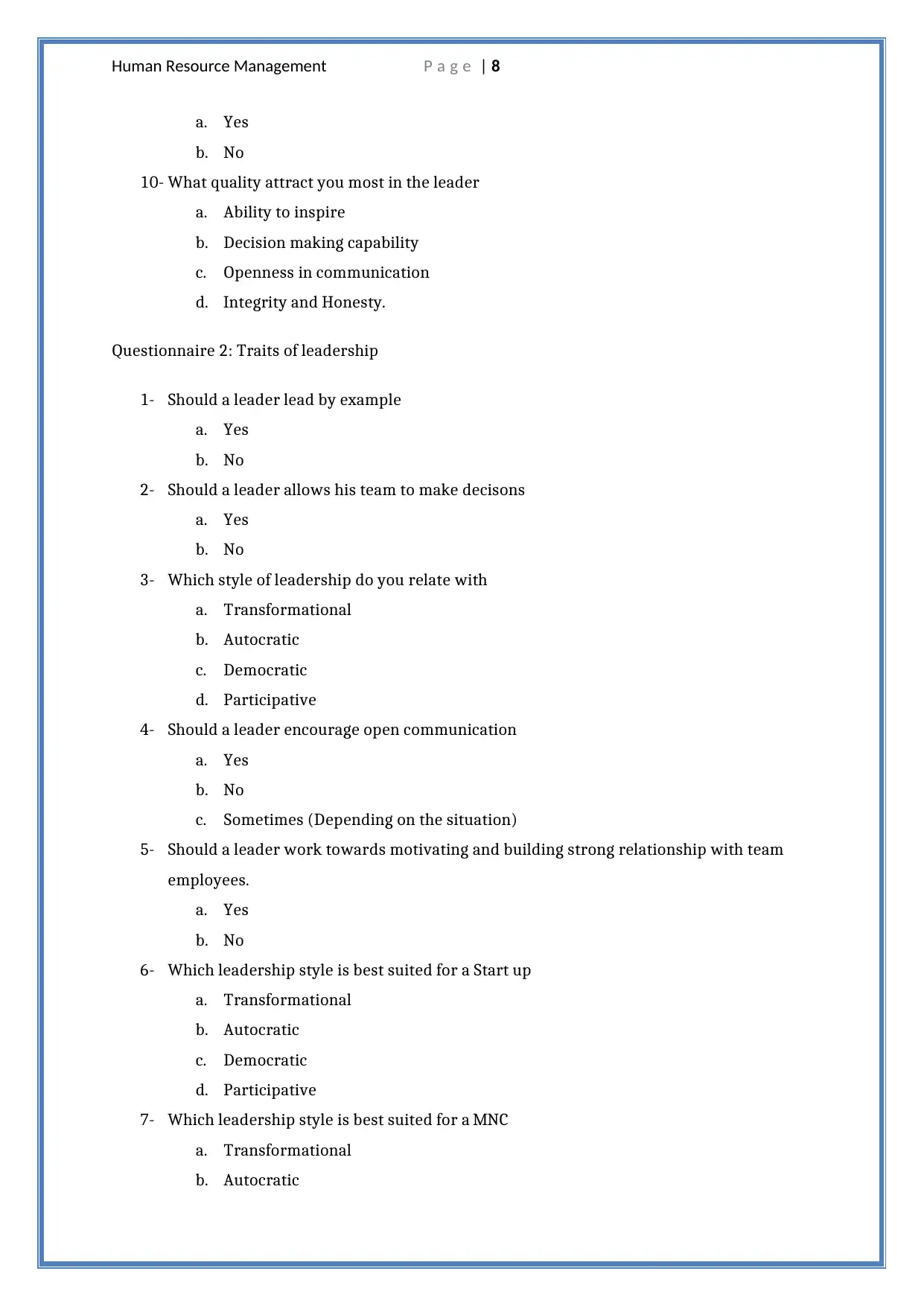
Human Resource Management P a g e | 8
a. Yes
b. No
10- What quality attract you most in the leader
a. Ability to inspire
b. Decision making capability
c. Openness in communication
d. Integrity and Honesty.
Questionnaire 2: Traits of leadership
1- Should a leader lead by example
a. Yes
b. No
2- Should a leader allows his team to make decisons
a. Yes
b. No
3- Which style of leadership do you relate with
a. Transformational
b. Autocratic
c. Democratic
d. Participative
4- Should a leader encourage open communication
a. Yes
b. No
c. Sometimes (Depending on the situation)
5- Should a leader work towards motivating and building strong relationship with team
employees.
a. Yes
b. No
6- Which leadership style is best suited for a Start up
a. Transformational
b. Autocratic
c. Democratic
d. Participative
7- Which leadership style is best suited for a MNC
a. Transformational
b. Autocratic
a. Yes
b. No
10- What quality attract you most in the leader
a. Ability to inspire
b. Decision making capability
c. Openness in communication
d. Integrity and Honesty.
Questionnaire 2: Traits of leadership
1- Should a leader lead by example
a. Yes
b. No
2- Should a leader allows his team to make decisons
a. Yes
b. No
3- Which style of leadership do you relate with
a. Transformational
b. Autocratic
c. Democratic
d. Participative
4- Should a leader encourage open communication
a. Yes
b. No
c. Sometimes (Depending on the situation)
5- Should a leader work towards motivating and building strong relationship with team
employees.
a. Yes
b. No
6- Which leadership style is best suited for a Start up
a. Transformational
b. Autocratic
c. Democratic
d. Participative
7- Which leadership style is best suited for a MNC
a. Transformational
b. Autocratic
⊘ This is a preview!⊘
Do you want full access?
Subscribe today to unlock all pages.

Trusted by 1+ million students worldwide
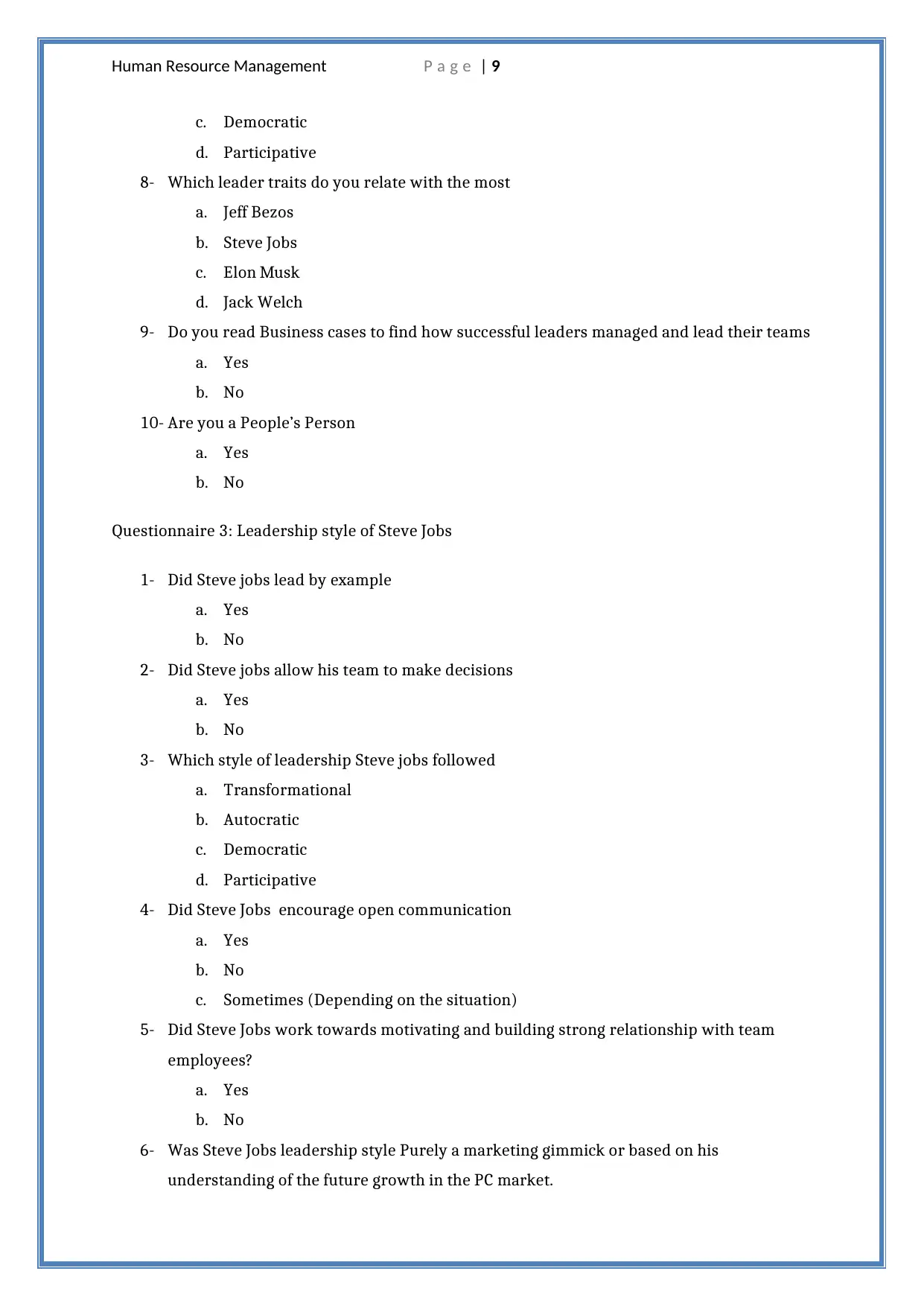
Human Resource Management P a g e | 9
c. Democratic
d. Participative
8- Which leader traits do you relate with the most
a. Jeff Bezos
b. Steve Jobs
c. Elon Musk
d. Jack Welch
9- Do you read Business cases to find how successful leaders managed and lead their teams
a. Yes
b. No
10- Are you a People’s Person
a. Yes
b. No
Questionnaire 3: Leadership style of Steve Jobs
1- Did Steve jobs lead by example
a. Yes
b. No
2- Did Steve jobs allow his team to make decisions
a. Yes
b. No
3- Which style of leadership Steve jobs followed
a. Transformational
b. Autocratic
c. Democratic
d. Participative
4- Did Steve Jobs encourage open communication
a. Yes
b. No
c. Sometimes (Depending on the situation)
5- Did Steve Jobs work towards motivating and building strong relationship with team
employees?
a. Yes
b. No
6- Was Steve Jobs leadership style Purely a marketing gimmick or based on his
understanding of the future growth in the PC market.
c. Democratic
d. Participative
8- Which leader traits do you relate with the most
a. Jeff Bezos
b. Steve Jobs
c. Elon Musk
d. Jack Welch
9- Do you read Business cases to find how successful leaders managed and lead their teams
a. Yes
b. No
10- Are you a People’s Person
a. Yes
b. No
Questionnaire 3: Leadership style of Steve Jobs
1- Did Steve jobs lead by example
a. Yes
b. No
2- Did Steve jobs allow his team to make decisions
a. Yes
b. No
3- Which style of leadership Steve jobs followed
a. Transformational
b. Autocratic
c. Democratic
d. Participative
4- Did Steve Jobs encourage open communication
a. Yes
b. No
c. Sometimes (Depending on the situation)
5- Did Steve Jobs work towards motivating and building strong relationship with team
employees?
a. Yes
b. No
6- Was Steve Jobs leadership style Purely a marketing gimmick or based on his
understanding of the future growth in the PC market.
Paraphrase This Document
Need a fresh take? Get an instant paraphrase of this document with our AI Paraphraser

Human Resource Management P a g e | 10
a. Yes
b. No
c. Cant Say
7- Was Steve Jobs a better leader than Tim Cock
a. Yes
b. No
8- Did Steve Jobs adopt the same leadership style while leading Pixar and Next, in
comparison to Apple
a. Yes
b. No
c. May Be
9- Did firing Steve jobs mellowed him and transformed his leadership style
a. Yes
b. No
10- The best trait you appreciate the most in Steve jobs
a. Future visionary
b. Charismatic Personality
c. Ability to never give up/ Perseverance
d. Creativity and Innovation
e. Excellent Stage orator.
Activity 1
Team Activity: In a team of 20, it is required that One of you become a Team leader and help the
team to come up with at least 10 ideas to promote the usage of technology in business practices
and policies of the organization to walk on the path of customer –centricity. It has to be ensured
that the team leader ensures that every person participates in the brainstorming and come up
with at least 2 ideas each. The ideas have to be discussed in a democratic manner and reaching
on a group consensus is most important. Towards the end Team leader has to give feedback on
the group performance.
Time allocated: 2 Hours
Activity 2
Amazon is looking to expand into Asian market and in order to do the same, a meeting has been
confirmed with the CEO of Softbank. The purpose here for the team is to create a presentation
a. Yes
b. No
c. Cant Say
7- Was Steve Jobs a better leader than Tim Cock
a. Yes
b. No
8- Did Steve Jobs adopt the same leadership style while leading Pixar and Next, in
comparison to Apple
a. Yes
b. No
c. May Be
9- Did firing Steve jobs mellowed him and transformed his leadership style
a. Yes
b. No
10- The best trait you appreciate the most in Steve jobs
a. Future visionary
b. Charismatic Personality
c. Ability to never give up/ Perseverance
d. Creativity and Innovation
e. Excellent Stage orator.
Activity 1
Team Activity: In a team of 20, it is required that One of you become a Team leader and help the
team to come up with at least 10 ideas to promote the usage of technology in business practices
and policies of the organization to walk on the path of customer –centricity. It has to be ensured
that the team leader ensures that every person participates in the brainstorming and come up
with at least 2 ideas each. The ideas have to be discussed in a democratic manner and reaching
on a group consensus is most important. Towards the end Team leader has to give feedback on
the group performance.
Time allocated: 2 Hours
Activity 2
Amazon is looking to expand into Asian market and in order to do the same, a meeting has been
confirmed with the CEO of Softbank. The purpose here for the team is to create a presentation
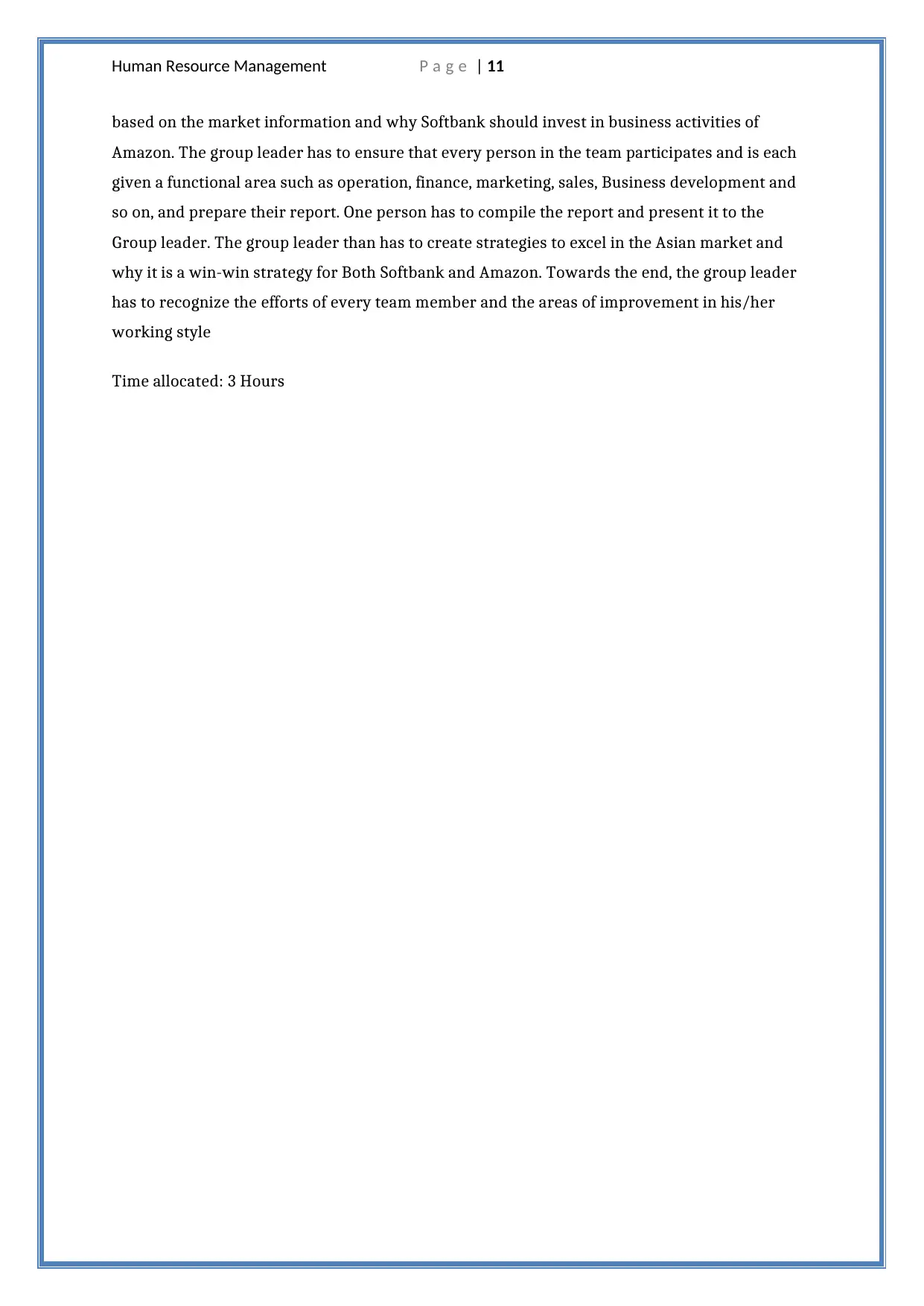
Human Resource Management P a g e | 11
based on the market information and why Softbank should invest in business activities of
Amazon. The group leader has to ensure that every person in the team participates and is each
given a functional area such as operation, finance, marketing, sales, Business development and
so on, and prepare their report. One person has to compile the report and present it to the
Group leader. The group leader than has to create strategies to excel in the Asian market and
why it is a win-win strategy for Both Softbank and Amazon. Towards the end, the group leader
has to recognize the efforts of every team member and the areas of improvement in his/her
working style
Time allocated: 3 Hours
based on the market information and why Softbank should invest in business activities of
Amazon. The group leader has to ensure that every person in the team participates and is each
given a functional area such as operation, finance, marketing, sales, Business development and
so on, and prepare their report. One person has to compile the report and present it to the
Group leader. The group leader than has to create strategies to excel in the Asian market and
why it is a win-win strategy for Both Softbank and Amazon. Towards the end, the group leader
has to recognize the efforts of every team member and the areas of improvement in his/her
working style
Time allocated: 3 Hours
⊘ This is a preview!⊘
Do you want full access?
Subscribe today to unlock all pages.

Trusted by 1+ million students worldwide
1 out of 12
Related Documents
Your All-in-One AI-Powered Toolkit for Academic Success.
+13062052269
info@desklib.com
Available 24*7 on WhatsApp / Email
![[object Object]](/_next/static/media/star-bottom.7253800d.svg)
Unlock your academic potential
Copyright © 2020–2025 A2Z Services. All Rights Reserved. Developed and managed by ZUCOL.





